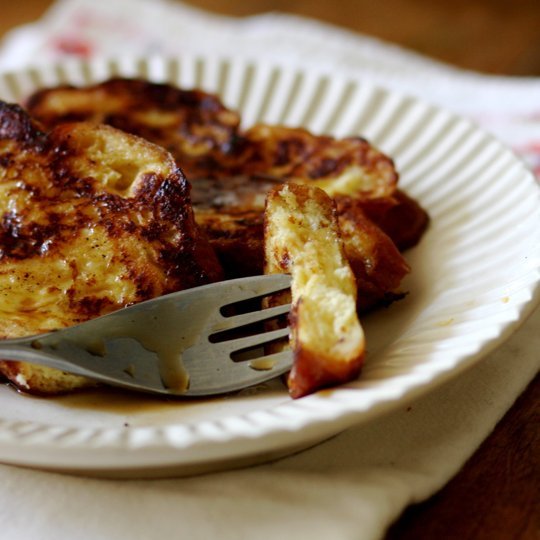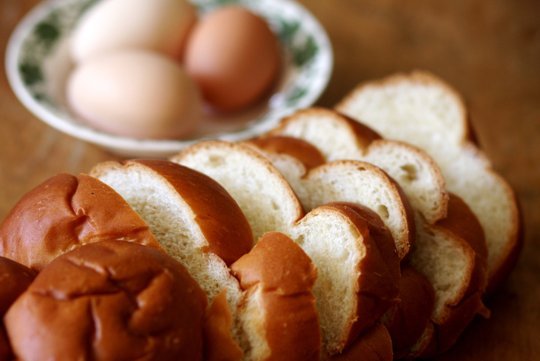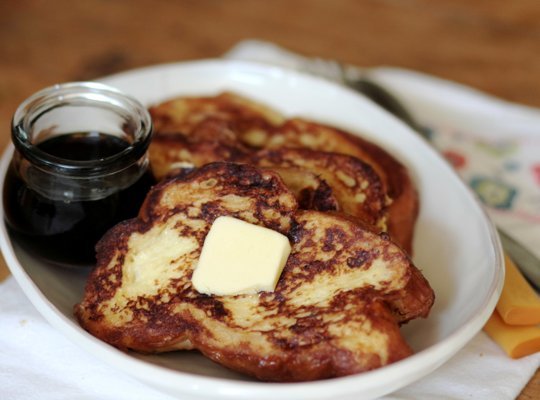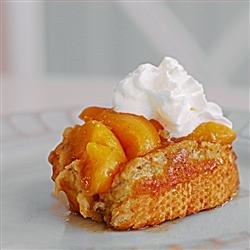How to Make Great French Toast

Ah, French toast! That iconic, special-occasion, breakfast-in-bed treat that so many people long for ... only to end up with soggy, burnt toast and a big mess in the kitchen. I think I had basically given up on making French toast because this is always how mine ended up. It's just dang sad because French toast is one of my husband's favorite things in the whole world so after reading many helpful tips on making great French toast I can finally make it for him again! Hooray! I wanted to share these tips with you guys just in case this is a breakfast that can use some work for you too.
The ideal French toast is browned and crispy on the outside and creamy on the inside. It is not dry and it is not soggy. It has a rich, custard flavor (without being too eggy), and is usually sweetened with sugar and garnished with maple or fruit syrup, fresh fruit, and butter - but it can be served savory as well.
French toast has very few ingredients, so it's important to pay attention to them. Try to purchase quality eggs, use half-and-half if possible, and select the right bread for the kind of results you are looking for - and don't skimp on the maple syrup!
What Goes Into Making French Toast:

The Bread
French toast is mostly bread, so the kind of bread you use is important. Challah or egg bread is made with eggs and butter and will give you gorgeous creamy insides. This is a go-to bread for French toast for many people. Tightly crumbed, country-style breads are nice, too, and will give you a sturdier, less creamy French toast. Classic French baguettes sliced on the diagonal make a nice, chewy version. You can even use croissants or banana bread.
Just avoid generic white sandwich bread and rustic breads with large holes and thick crusts if at all possible. The rustic bread just won't hold the custard and the generic bread is too soft and characterless.
It is a great idea to purchase a loaf that is not pre-sliced so you can have control over how thick your slices are. Cut your slices at least a one-inch-thick, which helps keep the bread from becoming too soggy while promoting a nice, creamy interior. Ideally it should be slightly stale, as fresh bread will often end up with a limp texture. What a delicious way to cut down on food waste too! Rich breads like challah and egg bread can be left out with the wrapper open the night before, but country breads are better if kept packaged. Bottom line: It's not the end of the world if your bread is fresh, but a slightly stale loaf is preferable.
Custard
Eggs and milk are whipped together into a smooth mixture in which you dip the bread before cooking. Half-and-half or cream will make a richer custard than
whole or skim milk. You can also use non-dairy milks such as almond and coconut.
Some people simply dip their bread in the custard, which works okay with the thinner, pre-sliced sandwich bread. The sturdier country loaf and baguette can handle a longer soak, which will also help to soften their often tough crusts. With thick slices of challah, I find that a short soak produces the best texture.
When whisking the eggs and half-and-half for the custard, be sure the egg is completely whisked into the liquid and there are no bits of white or yolk - any un-whisked bits of egg will cook up hard and separate. Finally, be sure to let the excess custard drip off of the bread before you place it in the pan to avoid a custard puddle forming beneath the bread as it cooks.
How To Make Great French Toast

Makes 8 slices
What You Need
Ingredients
3 large eggs
1 cup half-and-half
Pinch of salt
1 tablespoon of sugar
8 slices stale challah bread or other rich bread, sliced 1-inch thick
2 to 3 tablespoons butter, plus more for serving
Toppings (see Recipe Notes)
Equipment
Measuring cups and spoons
8x8-inch cake pan, or other pan that will hold 4 slices of bread
Whisk or fork
12- to 14-inch skillet
Spatula
Serving platter
Instructions
1. Whisk the eggs, half-and-half, salt, and sugar in the cake pan until the egg is completely incorporated into the liquid.
2. Ready your cooking space: Place the frying pan on the stove over medium-low heat. Move the pan with the custard next to the stove.
3. Soak the French toast: Place four slices of bread into the custard to soak for one minute. Flip the slices and soak another minute.
4. Cook the French toast: While the bread is soaking, add 1 tablespoon of butter to the pan. When it starts to foam, tilt the pan to completely coat the bottom. Lift one piece of bread from the custard and hold it briefly over the custard to let any excess drip off. Lay the bread gently in the frying pan. Repeat with additional pieces.
5. Flip the French toast: After a few minutes, peek under a slice of bread to see if the French toast has turned golden and browned. When it has, flip each piece and continue cooking. Monitor and adjust the heat so the toast doesn't burn.
6. Soak the remaining bread: When the first batch has nearly finished cooking, place the remaining four slices of bread in the custard to soak, one minute per side.
7. Cook the second batch: As the first batch of French toast finishes, transfer the pieces to a serving platter. Wipe out the frying pan. Return the pan to the flame, add 1 tablespoon of butter and cook the second batch of French toast as described above.
Recipe Notes:
- Additions for sweet French toast : You can add a touch of cinnamon or nutmeg to the custard or a tablespoon of brandy or a teaspoon of vanilla. Other popular additions include orange or lemon zest.
- Sweet toppings for French toast: Maple syrup is classic, but you can branch out into other kinds of syrups, fruit sauces, or jams. Fresh fruit and powdered sugar are also popular.
- For savory French toast: Omit the sugar in the custard. Top with sautéed vegetables, Parmesan cheese, and/or cooked ham or chicken.
Other Methods for Delicious French Toast:
Fried and baked. This 2-step cooking method is the secret to restaurant-quality French toast. The bread is saturated with custard and pan-fried until crisp and brown on both sides. After that, it's baked for a few minutes to allow the custard to finish cooking and make the bread puff up beautifully.
Baked. A casserole approach to French toast that makes a great breakfast for a crowd. Even better, you can prep it the night before and bake it in the morning.
When I lived in Utah, I often found myself as kind of bed and breakfast for my family who would visit regularly from Idaho, and almost every time I made a deal with my mom that if she brought me a jar of her delicious canned peaches I would make everyone a batch of my favorite overnight peach French toast. It is unbelievably delicious! I think she liked coming for the French toast more than just to see little old me ;)
Stuffed. A surprise in every bite. You can either fill the bread with stuff, like a cream cheese mixture inside a nice, thick piece of crusty old French bread, or you can sandwich the stuff between two slices of bread, as in a Raspberry Cheesecake Stuffed French Toast. (You can google and find many good recipes for any of these methods, I don't want to overwhelm you with too many recipes!)
Here is the recipe for the Peach Overnight French Toast:

Ingredients:
- 1 cup packed brown sugar
- 1/2 cup butter
- 2 tablespoons water
- 1 (29 ounce) can sliced peaches, drained
- 12 (3/4 inch thick) slices day-old French bread
- 5 eggs
- 1 tablespoon vanilla extract
- 1 pinch ground cinnamon, or to taste
Directions
- In a saucepan, stir together the brown sugar, butter and water. Bring to a boil, then reduce heat to low, and simmer for 10 minutes, stirring frequently.
- Pour the brown sugar mixture into a 9x13 inch baking dish, and tilt the dish to cover the entire bottom. Place peaches in a layer over the sugar coating, then top with slices of French bread. In a medium bowl, whisk together the eggs and vanilla. Slowly pour over the bread slices to coat evenly. Sprinkle cinnamon over the top. Cover and refrigerate for 8 hours or overnight.
- Remove the dish from the refrigerator about 30 minutes before baking to come to room temperature. Preheat the oven to 350 degrees F (175 degrees C).
- Bake for 25 to 30 minutes in the preheated oven, or until the bread is golden brown. Spoon out portions to serve.
- www.thekitchn.com
- www.allrecipes.com
 Mary Richardson
Mary Richardson
Weekly Newsletter Contributor since 2014
Email the author! mary@dvo.com
